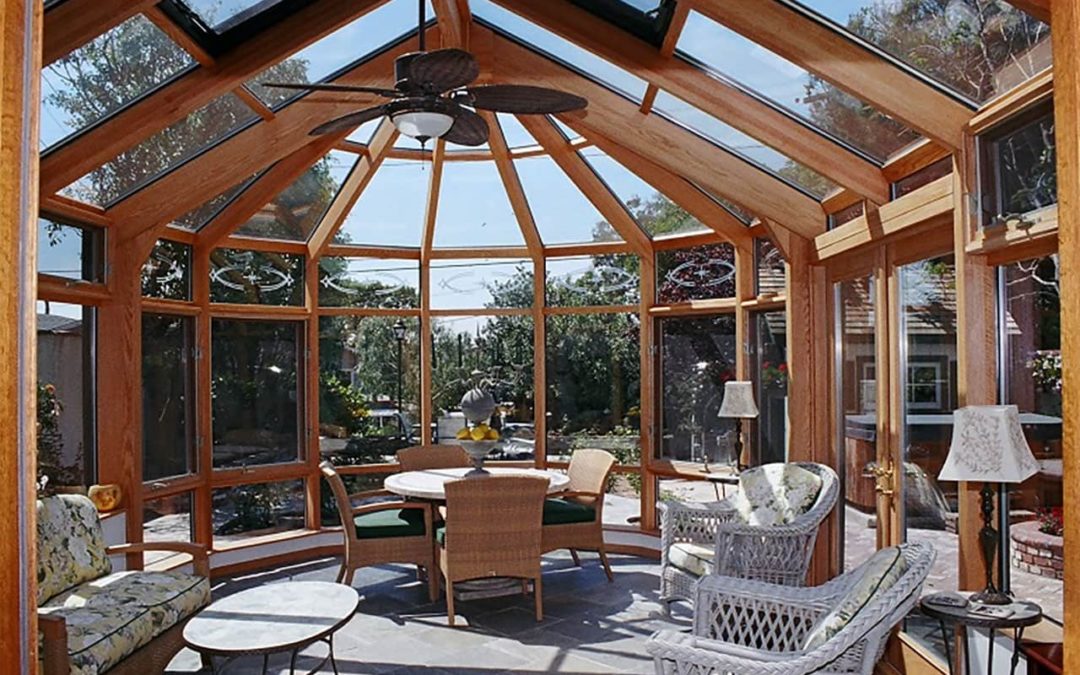Enjoying the view of the outdoors from the comfort of your own sunroom should mean you can experience all of the benefits of being outdoors without worrying about inclement weather. Unfortunately, high and low outdoor temperatures can reduce the comfort level of your sunroom, especially if it was not designed to be a four seasons room. Whether you are in sunny southern California or in an area like Salt Lake City where changing seasons bring heating and cooling challenges, mitigating the effects of outdoor temperatures in your sunroom is possible.
You want to see the outdoors, not feel it in your sunroom. Designing your sunroom to be comfortable in all seasons before you build can save time and money, but changes in an existing sunroom can make a big difference too. Cost, energy efficiency, and location are key factors to consider as you decide which heating and cooling solutions are best for your sunroom.
4 Ways to Keep Your Sunroom Cool
Window Treatments
Shades, blinds, and other window treatments can be used to block windows in direct sunlight during the heat of the day, and opened to allow views and indirect sunlight
Solar shades in a light color will allow light to come in while still having a view of the outdoors, but the shade will prevent some of the heat from coming in. Solar shades can be raised and lowered throughout the day to maximize outdoor viewing and prevent overheating the room.
Air Circulation
Increasing airflow will help keep your sunroom cool in the summer. Venting your sunroom with operable skylights is a great way to allow rising warm air out and fresh air into the room. Professionally installed skylights are available in a wide range of styles and materials to match the interior and exterior of your home.
If your ceiling height is at least eight feet, overhead fans can be installed in your sunroom to provide additional air circulation. Most ceiling fans change direction to pull warm air up during the summer, and push cool air down during the winter. Overhead fans work in tandem with your HVAC or ductless system to keep the cost of heating and cooling down.
Opening sliding sunroom windows and your staging doors can also increase air circulation for cooling the room. Creating a cross breeze between sliding windows for ventilation often has the side-effect of being pleasant.
Upgrade Windows
Upgrading your windows provides year-round comfort. Most modern sunrooms are built with high performance dual pane glass, but older sunrooms may need upgraded windows to provide the insulation needed to prevent rising temperatures on warm days. Knowing your local climate will help you decide if upgrading the windows will provide the edge you need to combat extreme highs in summer or lows in winter. When outside temperatures soar, energy efficient low emissivity (Low E) insulated glass sunroom windows provide cost-saving protection from rising temperatures in your home.
Control the Climate in Your Sunroom
Extending ductwork connecting your sunroom to the heating, ventilation and air conditioning (HVAC) system in your home will enable you to control the climate inside as the temperature changes outside. Vents can be strategically installed in the floor or wall of your sunroom to maximize airflow. A separate thermostat can control the room temperature for additional comfort in the sunroom. Adding another room to your existing HVAC system may not be possible if the system does not have the capacity to handle the additional load, the location of the sunroom limits the ability to effectively add ductwork, or the cost is prohibitive.
Climate control in your sunroom can also be added as a system separate from your main HVAC system. A ductless system (mini split) can be installed in most sunrooms where connecting to the HVAC system is not the best solution.
4 Ways to Warm Your Sunroom
Some of the strategies used to keep your sunroom cool on hot days can also keep your sunroom warm on cold days. Controlling the climate of your sunroom with your HVAC or ductless system is a year-round solution. Upgrading windows and employing overhead fans are also strategies that work well in cities like Spokane, WA where snow covers the frozen ground for months. Keeping your sunroom warm through winter in colder climates can be challenging, but we have a few tips to help.
- Covering your floor with an area rug and pad will provide some insulation, create a warmer surface for your feet, and give your sunroom a cozy design update for the season.
- Installing radiant heating in the floor will help keep the sunroom warm on cold days.
- Thermal-insulated draperies and other window treatments can help keep warm air in and cold air out during the cold months.
- Adding a heat source to the room can make the sunroom more pleasant during cold months. Cities like Portland, Oregon enjoy a moderate climate where a space heater can keep the chill away on cold days, and be stored away when it is not needed.
- An electric, gas, or wood fireplace brings ambiance and heat to your sunroom. Check with your local dealer to learn more about permitting and service availability in your area.
Before You Build
Designing your sunroom to be used all year will save money over time. Taking advantage of energy efficient materials like low E windows, and building utilizing modern sunroom technologies ensures that you and your family will enjoy your sunroom for many years.
Global Solariums Dealers near you are ready to answer your questions about building and maintaining sunrooms in your area. To learn more and get a free no-obligation quote, contact us today!

